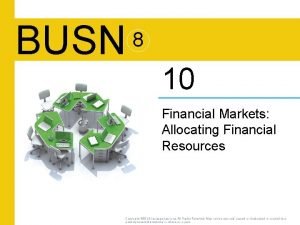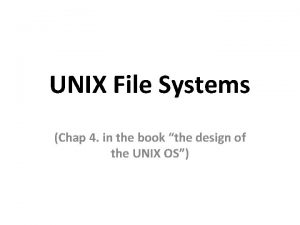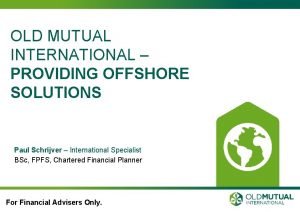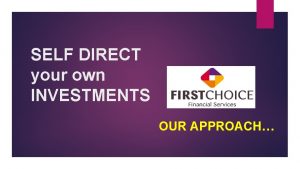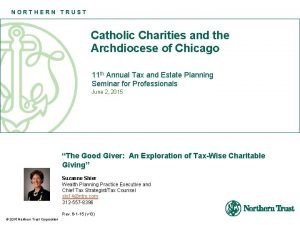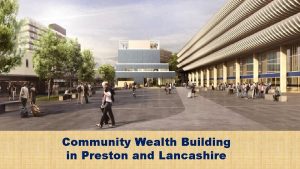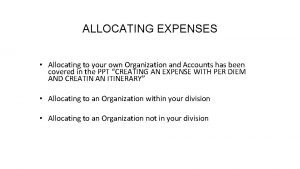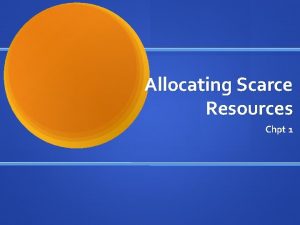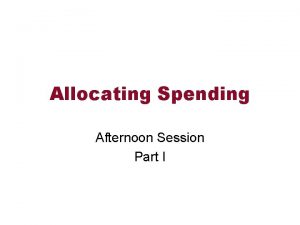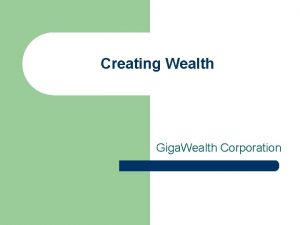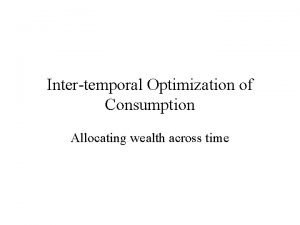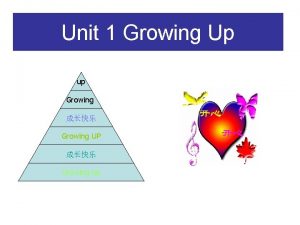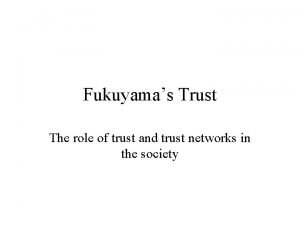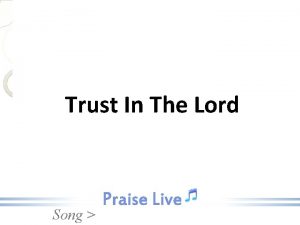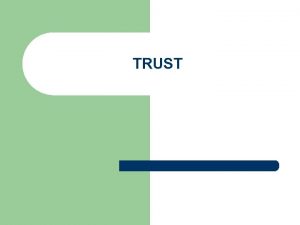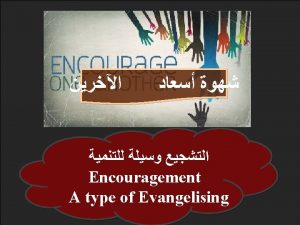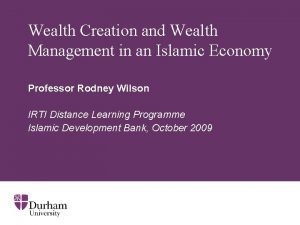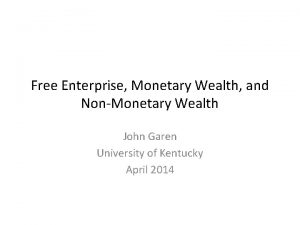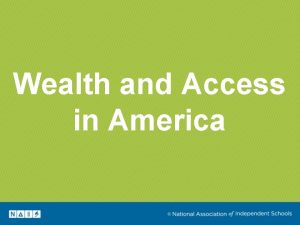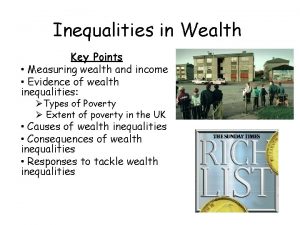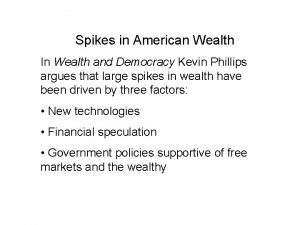Growing and Allocating your Trust Wealth for the























- Slides: 23

Growing and Allocating your Trust Wealth for the Betterment of your Community Trustee Workshop, Yukon First Nation Trust Symposium November 2014

Review: What is a Trust? l Trusts are often used to hold large land or specific claim settlements, and also certain sharing arrangements (IBA), own source revenues, treaty payments to benefit the community for today and often for “ 7 generations”. l The Trust is separate and protected from other assets of the Nation, separate from Chief and Council, and is transparent and accountable to Community as its Citizens, the beneficiaries. l Usually a Trust ensures a long term consistent flow of benefit to the Community. l As Trustees you are in charge of managing the Trust property for the beneficiaries, being your Community, according to the terms of the Trust and the laws governing Trusts, for as long as the Trust exists. This relationship of you to the Trust and community is called a fiduciary.

Investing to Grow the Trust Investing the Trust assets is the most important job of the Trustees and fundamental to Trust success. Goals of Investing: l l Protect the capital Grow the capital Generate income to spend in community. Benefit the Community Subject to : what Trust Deed says AND the Trustees Act in your jurisdiction 4 Key Factors to determining how to Invest: l Time Horizon ( how long will funds be invested) l Withdrawals ( how much, how often) l Liquidity needs ( short and long term) l Tolerance for volatility in short term

Bringing it Together…. Constraints? l. If liquidity is an issue and cash will be required…the portfolio must be convertible to cash. Money market, all marketable securities, stocks, bonds. Real estate can take months to sell and Direct business investments are generally not liquid. l. What does the Trust Agreement say about how to invest? l. Longer time horizons can generally accept more volatility in shorter and longer term. l. Need to guarantee capital will reduce risk threshold less stock, less real estate, less companies. More guaranteed product.

Asset Allocation is “ Everything” l Asset allocation is the process where Trustees select, with the help of their advisors, the right mix investments for their portfolio. Trustees “allocate” specific percentages of Trust funds between the two major asset groups. l Cash/Bonds –SAFETY. Lower risk, lower volatility, lower returns, consistent income, capital protection. l Equity/Stocks- GROWTH. Higher risk, higher returns traditionally higher volatility. What other kinds of Equity? Real estate? Private Companies? l How much volatility? What timeline is capital and income required? Optimal relationship between risk and return. Similar to diversification, asset allocation refers to the portioning of a portfolio among various types of investment asset classes so as to maximize return for a given level of risk. Experts conclude that constructing an efficient portfolio is the key to optimizing returns for a given level of risk.

Governance Model: The IPS The Investment Policy Statement (IPS) is the key governance document for the investment function of the Trust. The IPS, often referred to as the Statement of Investment Policy and Goals (SIP&G), should be developed by the Trustees with the assistance of an Investment Consultant or the Portfolio Manager and /or other advisors or elected officials. The IPS is developed to reflect the goals and objectives of the First Nation Community and address constraints like diversity, risk, asset mix ( stocks, bonds) term, cash flow needs, income tax considerations, volatility range etc. l Where the Trustees want to delegate Investment authority, the IPS allows the Discretionary Portfolio Manager to make the day to day decisions within the framework of the IPS. n Hire someone who has experience and a good fit for your community. Build a relationship with them ! Adapt over time: learn and grow together. l Where the Trustees wants more direct control , they can also self manage assets with a broker, or Investment Advisor, or buy real estate or directly own companies. l Hybrid IPS, part discretionary managed portfolio, some private equity or real estate.

Investment Modelling for Aboriginal Trusts Generally a Discretionary portfolio, with a licensed portfolio manager or Investment Counsellor is recommended (per NATOA) and required in many Trust Agreements. Why? l They are experts in the field and have access to all the research, data on macro economics, sectors, industries and stock/bond selections. l The experts make day to day decisions on the account. Trustees do not have to buy and sell securities. l The Discretionary Portfolio Manager owes a Fiduciary duty of care to the Trustees. How? l They develop an investment policy statement with you to outline the various terms they will operate within, like asset allocation, liquidity, term. Sometimes an Investment Consultant or other professional advisors involved. l Make sure its flexible and suits Trusts and Nation’s goals. l Review results, evaluate objectively and adjust.

Portfolio Construction for a Managed Portfolio Investment Research Team Lead Relationship Manager-led Discovery • • • Experience • Resources • Analysis Client goals Risk profile Time horizon Legal & tax issues Investment Policy Statement (Investment Counsellor and Client) • Economic climate • Capital markets • Investment research Mandates (Asset Mix Committee ) Client Portfolio Ongoing servicing, management and review

Asset Allocation – Benchmarks and Ranges 3% (0 -20%) 20% (10 -35%) 35% (25 -47%) 50% (40 -60%) Return 65% (55 -75%) 80% (70 -90%) 100% (100%) Fixed Income 20% (10 -30%) Focused Income Styles: Conservative Income 35% (25 -45%) Balanced Income Styles: Conservative Income 80% (65 -90%) 50% (40 -60%) Balanced Styles: Growth Conservative Income 65% (53 -75%) Balanced Equity Styles: Growth Conservative Income Focused Equity Styles: Growth Conservative Income 97% (80 -100%) All Equity Styles: Growth Conservative Income Benchmark (Range) Capital Preservation Capital Appreciation Risk

Private Equity Investments Increasingly there is desire to use a Trust to further own source revenues, create business and employment opportunities. These bring capacity and opportunities to the community and invest in the membership and local economy. l Requirements: l Trust deed must allow for private equity, business ownership, real estate and other non traditional investments. l Must fit your risk profile. Can be considered a high risk investment so should be taken into over all investment strategy IPS. l Must be a viable opportunity: Business plan solid, leadership solid, reporting required. l Who will manage it? Monitor it? Who decides? l Environmental concerns? l Risk management? l Any Nation politics?

More on Private Equity Investments Possible Solutions to make it work: l Use of Independent First Nation Board. l Conflict of Interest Policy. l Due Diligence on each request. l Retain Experts or Independents to advise on viability and requirements for success. l Work with Community Development Corporation. Trustees are liable and accountable for decisions made, so care must go into any private equity decisions. l The Trust must allow for it. l Its should be a portion of your overall IPS strategy, not all of it. l Your Nation must have capacity and governance to do this.

Spending the Income and Capital Very dependant on what the Trust Deed says about allocation of income and capital. l Are their specific purposes in the Trust? l Liquidity needs - per cap payments? Christmas bonus? l Annual income payments? ( who decides? how spent? ) l Program dollars flow through? l Long term capital encroachment allowed? l Leverage allowed? ( Buy real estate? l New Programs or Opportunities in the Community goals? Council objectives? l Private Business Opportunities? Development Corp. opportunities? Build a new community centre using Trust income to pay loans. )

How to Manage Spending? Look to What the Trust says for spending and purposes in general and then start with long term growth plan. l Expected growth, expected income l Short term payments – annual income? per cap payments? l Fees- should not exceed 2% of Trust l Long term goals. Priorities in Trust or other document? l What are communities goals? How to engage community? l Ideas: § Create a bylaw that allocates how funds will be used annually, such as percentage ranges to address different priorities. Make it amendable with community ratification. § Require a community vote to approve large dollar decisions?

What’s a Communication Strategy? l Not usually spelled out in the Trust. The Trust may require an annual meeting or certain reporting requirements to the community. l Draft a communication plan and Trustees agree to it. l Improves transparency, knowledge, governance and capacity in Community. l Include: l Who talks to community, when, how often? n biannual community meetings. n quarterly newsletters with an update on the Trust. n access to Trust information for community? A binder in the community? n AGM to decide on priorities for Trust income and capital? n Interface with Elected officials? l A process for how the community gets to talk to the Trustees. n I recommend office hours, a mailbox for ideas/requests. n complaint process to feel heard

Some closing ideas… l Make sure you spend time learning about the Trust and what you’re supposed to do, what you can do. l Build Capacity: l Education. NATOA or other courses, trust training, professional workshops, bring in experts. l Community. Programs to create employment and invest in your communities strengths, investing in small business, programs to build knowledge in the community. l Hire professionals that “get it” and understand your community and what you are trying to accomplish. Draw on their expertise. l Communicate, build consensus! Community meetings, open transparent communication available to all. l Educate your youth about your Trust.

BMO Bank of Montreal l BMO was founded in 1817 in Montréal, and is Canada's oldest bank l BMO has 1, 230 bank branches in Canada and the United States l Operates through 3 operating groups: 1. Personal and Commercial Banking (P&C) 2. Private Client Group (PCG) 3. BMO Capital Markets

Aboriginal Banking Unit at BMO The Aboriginal Banking Unit was created in 1992 to serve the unique banking and financing needs of First Nations communities ~ More than 20 years of dedicated service to Aboriginal communities ~ Some milestones: Ø Created one of the first on-reserve housing loan programs in Canada Ø The first and only major financial institution involved with First Nations Market Housing Fund and the First Nations Finance Authority Ø Developed a lending directive that clearly outlines how to get beyond the barriers of the Indian Act with regards to lending, particularly with infrastructure loans Ø Continue to provide unique and innovative financing products

Other Initiatives l Sponsorships: l CCAB (Canadian Council of Aboriginal Businesses) l CANDO (Council for the Advancement of Native Development Officers) l NATOA (National Aboriginal Trust Officers Association) l AFOA (Aboriginal Financial Officers Association) n We are also sponsoring our Commercial Account Managers to complete the Certified Aboriginal Financial Management certification throughout Canada l Belinda Stronach Foundation (One Laptop Per Child Campaign) l FAAY (Foundation for the Advancement of Aboriginal Youth) l NAAF (National Aboriginal Achievement Foundation) l DAREArts l Ron Jamieson Bursary through BMO l PAR Gold recipient

At BMO, We Have 2 Programs On-Reserve Housing Loan Program & On-Reserve Home Renovation Loan Program Together they: l Provide innovative on-reserve housing financing alternatives without government involvement l Are designed to reflect the specific requirements of a particular First Nation l Provide financing for the construction, purchase, &/or renovation of single family homes on reserve.

Types of Financing l l Infrastructure l Housing l Education/Employment/Training Centres l Housing loans l Administration Buildings l Renovation loans l Health Care Centres l First Nations Market Housing Fund l Social Service Buildings l Sports/Recreational Facilities l Elders’ Lodges l Ambulance/Fire Stations/Police Services Building l Sewer/Water projects l Roads/Bridges Project Financing l Solar Farms l Wind Energy

Infrastructure Financing Guidelines at BMO Ø Up to 100% of a project can be financed Ø Projects over $1, 000 can be financed with Banker Acceptance (BA’s) Ø 15 -20 Year Amortizations Ø Flexible Terms such as “Interest Only” during Construction

BMO’s commitment to Aboriginal Communities: BMO is committed to providing improved access to financial products and services to Aboriginal communities. We recognize that our ability to contribute to the self-sufficiency of Aboriginal communities is linked to the development of effective relationships with those communities. To foster these relationships, we are working with Aboriginal communities in a spirit of partnership and cooperation to build a workforce that better reflects the Aboriginal communities we serve, enhance our understanding of the needs of the communities to contribute to economic well being, build mutual trust and respect through open dialogue and discussion with Aboriginal communities, businesses and individuals, deliver value to our Aboriginal clients by providing improved access to financial products and services. Our Strategy We believe that working with Aboriginal communities to build mutually beneficial sustainable relationships is the best possible foundation for financial growth, success and prosperity. Our strategies to build effective relationships draw from our approach as follows: l develop innovative distribution channels to bring banking services closer to Aboriginal communities to help create a positive affect on local economies, l develop sound mechanisms to facilitate on-reserve lending without government guarantees to finance significant and varied infrastructure projects that help build healthy, vibrant communities, l increase employee representation by reaching out to Aboriginal communities through a series of special recruitment initiatives in partnership with Aboriginal educators, counsellors and internship networks, l create a diverse and equitable workplace that fosters the retention and advancement of Aboriginal people, l share knowledge and create mutual understanding between BMO corporate clients, business partners and Aboriginal communities to form strategic alliances and joint venture partnerships, l increase employee and community engagement by conducting workshops and seminars to advance financial literacy, participate in local events, and contribute to a wide range of activities including health, arts and culture, sports and athletics, l provide scholarship and bursary opportunities for Aboriginal youth to develop skills and training in support of their aspirations to contribute to the future economic and social development of their communities, l ensure appropriate Aboriginal protocols and processes are recognized and followed in order to earn the respect and trust of the Aboriginal communities we serve.

Thank You
 Allocation map
Allocation map Markets allocating resources
Markets allocating resources Namei algorithm
Namei algorithm Old mutual wealth discounted gift trust
Old mutual wealth discounted gift trust Wealth options dolphin trust
Wealth options dolphin trust Northern trust charitable trust
Northern trust charitable trust Build your wealth lancashire
Build your wealth lancashire How to tell if your still growing
How to tell if your still growing How to tell if your still growing
How to tell if your still growing Give us your hungry your tired your poor
Give us your hungry your tired your poor Fspos vägledning för kontinuitetshantering
Fspos vägledning för kontinuitetshantering Novell typiska drag
Novell typiska drag Nationell inriktning för artificiell intelligens
Nationell inriktning för artificiell intelligens Returpilarna
Returpilarna Varför kallas perioden 1918-1939 för mellankrigstiden?
Varför kallas perioden 1918-1939 för mellankrigstiden? En lathund för arbete med kontinuitetshantering
En lathund för arbete med kontinuitetshantering Underlag för särskild löneskatt på pensionskostnader
Underlag för särskild löneskatt på pensionskostnader Personlig tidbok
Personlig tidbok Sura för anatom
Sura för anatom Förklara densitet för barn
Förklara densitet för barn Datorkunskap för nybörjare
Datorkunskap för nybörjare Boverket ka
Boverket ka Debattartikel struktur
Debattartikel struktur För och nackdelar med firo
För och nackdelar med firo

